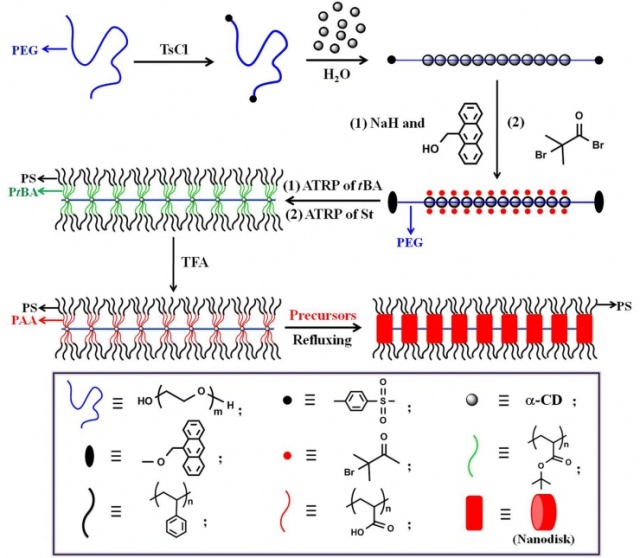Mar 31 2015
 Schematic shows the synthesis of organic-inorganic shish kebab-like nanohybrids composed of periodic nanodisk-like kebabs. (Credit: Zhiqun Lin)
Schematic shows the synthesis of organic-inorganic shish kebab-like nanohybrids composed of periodic nanodisk-like kebabs. (Credit: Zhiqun Lin)
Georgia Tech Researchers have developed a new method of fabricating nanometer-scale necklaces on the basis of small star-like structures threaded on to a polymeric base.
The method can offer a new approach to the production of organic-inorganic, hybrid, shish kebab structures from magnetic, semiconducting, ferroelectric and other materials, which may provide practical nanoscale characteristics.
The researchers have succeeded in creating nano-necklaces with up to 55 nanodisks. Using a living polymerization method, amphiphilic worm-like diblock copolymers are grown by the template-based process.
In this method, the polymeric structures act as nanoreactors, which form laterally linking nanocrystalline structures based on many different precursor materials. The average size of the nanodisks is around 10nm diameter, 4nm thickness and 2nm apart.
“Our goal was to develop an unconventional, yet robust, strategy for making a large variety of organic-inorganic hybrid shish kebabs,” said Zhiqun Lin, a professor in the School of Materials Science and Engineering at the Georgia Institute of Technology. “This is a general technique for making these unusual structures. Now that we have demonstrated it, we believe there is a nearly endless list of materials we can use to craft these nano-necklaces.”
The Air Force Office of Scientific Research and the National Science Foundation supported the research. The study results were published by the American Association for the Advancement of Science (AAAS) on March 27 in the journal Science Advances.
The applications of the single-dimensional nano-necklaces could be in electronic, optical, sensing, optoelectronic sectors. Till now, researchers have succeeded in producing structures from barium titanate(BaTiO3), cadmium selenide (CdSe) and iron oxide(Fe3O4). However, they are convinced it is possible to use several other materials such as gold.
The method commences with creation of inclusion complexes comprising alpha-cyclodextrins, which are cyclic oligosaccharides having six glucose units. The structure of the alpha-cyclodextrins is such that they have a hollow center and form into a polyethylene glycol (PEG) chain in a well-known self-assembly process. To retain the small structures, a large stoppering agent caps the polymer base on which the threaded alpha-cyclodextrins lie.
Each alpha-cyclodextrin comprises 18 hydroxyl (OH) groups that can be converted into bromine (Br) groups via esterification . Out of these bromine groups in solution, giblock polymer “nanoworm” structures are then grown.
Created from poly(acrylic acid)-block polystyrene (PAA-b-PS), these worm-like diblock copolymers comprise inner poly(acrylic acid) (PAA) and outer polystyrene (PS) blocks, which are hydrophilic and hydrophobic, respectively. Since a large number of diblocks grow on each alpha-cyclodextrin, the polymer base expands due to their crowding.
On a preferential basis, metallic ion precursors are integrated into the space consisting of inner PAA blocks of worm-like diblock copolymer nanoreactors to form crystals. Nano-necklaces looking like tiny centipedes are formed when once separate structures are connected by these crystals.
“We were surprised to see these nano-kebabs grown into a single inorganic structure using the worm-like diblock copolymers as nanoreactors,” said Lin. “Under transmission electron microscope imaging, you see nanodisk-like kebab structures periodically situated on the stretched polymer shish.”
In transmission electron microscope images, these nanodisk-like kebabs are seen clearly as they have materials with very high electron densities. However the linked PEG shish is not seen as it has a low electron density.
Initially the structures being formed were a surprise to Lin’s research team, who anticipated structures that looked like nanowires or nanorods. However simulations performed by team member Yuci Xu at Ningbo University in China confirmed the structure formation. The simulations also helped predicting the dimensions of the structures formed.
“Based on the simulation, we could understand the growth mechanism for this nano-necklace-like structure,” said Lin. “This nano-necklace arrangement is very much captured by the simulation. The simulation and experiments agree well, which increased our confidence that we understand the structures.”
Now that researchers have proved their growth technique, they are trying to characterize the small structures and ascertain potential applications. Although this area has not been researched, according to Li, the structures based on semiconducting materials could have electronic applications, with electrons tunneling through adjacent nanodisks.
“The significance of this approach is that there is no limitation on what materials you can make, and no limitation on the size and shape of the structures you can design,” he said. “There are many potentially advantageous characteristics that may be derived from this nanoreactor approach.”
Lin stated that there are other methods for forming nano-necklace structures, however no method deploys a nanoreactor approach or a similar template.
In future studies, Lin’s group aims at studying the characteristics of the fabricated structures, testing other prospective materials, and exploring suitable applications. While individual nanodisk properties have been previously studied, their group interactions may offer distinct properties.
“This paper represents an intriguing demonstration of forming hybrid organic-inorganic shish kebabs at the nanometer scale,” said Lin. “We are anxious to learn more about the unique properties that they may have, and explore potential applications.”
Further to the researchers mentioned, authors included Haiping Xia of Xiamen University in China, and Hui Xu, Xinchang Pang, Yanjie He and Jaehan Jung of Georgia Tech.